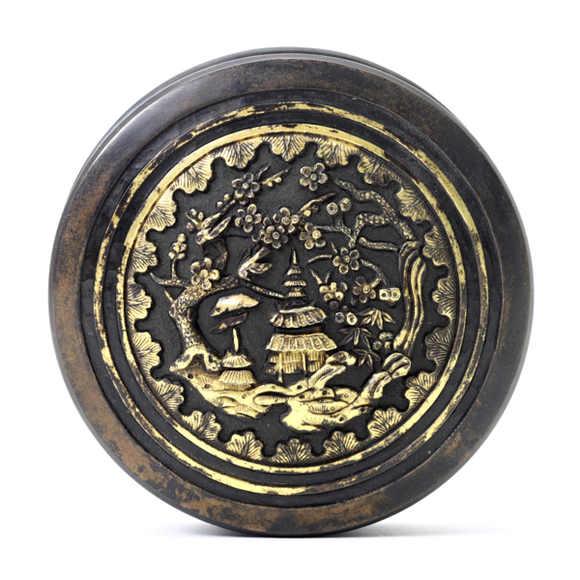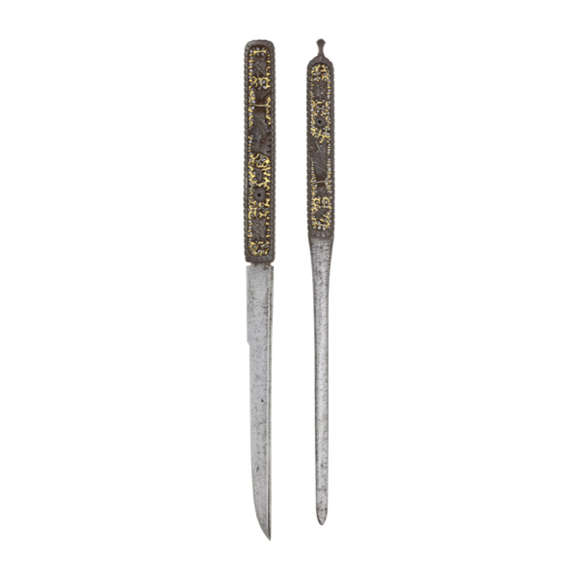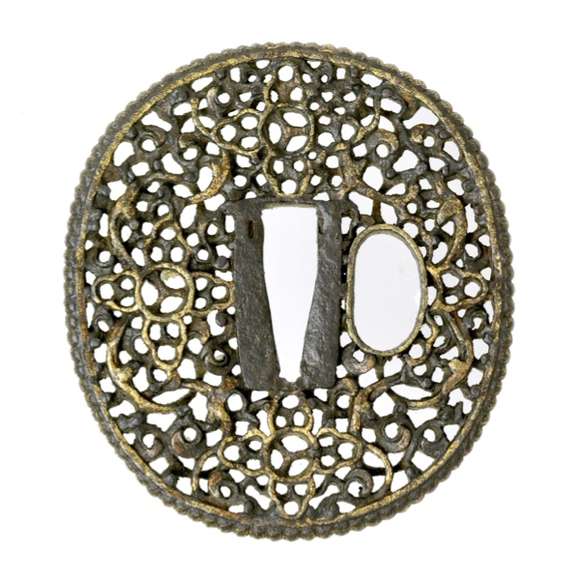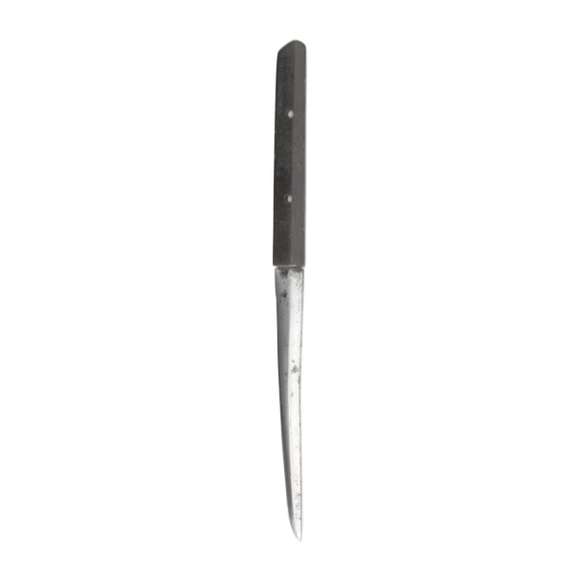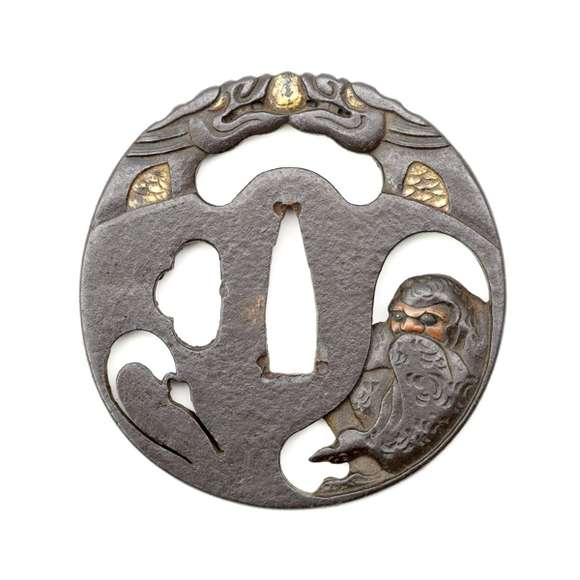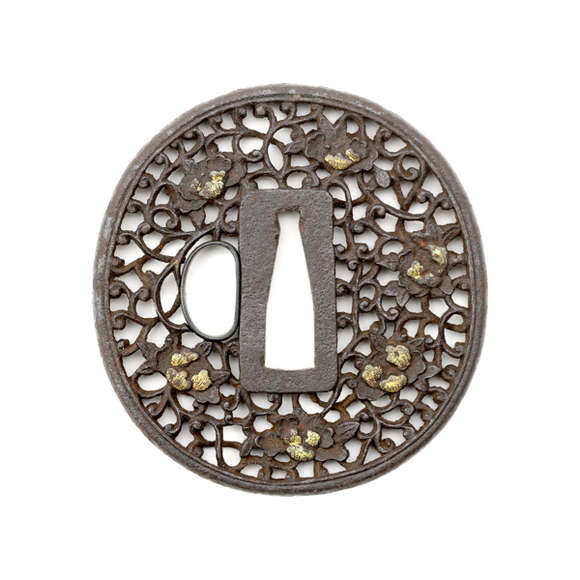Sawasa is metalware in black and gold made primarily for the Dutch expat community in Asia.

41 x 28 mm
38 grams
Sawasa, gold
Pommel probably Nagasaki
Filigree additions probably Batavia
18th century
From a Dutch private collection
Introduction
Sawasa is metalware in black and gold that made primarily for the Dutch expat community in Asia. It was most certainly produced in Nagasaki, probably by the Chinese community there, but also in Canton, Tonkin and possibly Batavia. VOC personnel also privately traded sawasa with Europe, and today sawasa wares can be found in various museum and royal collections.
The base material is an alloy containing copper and gold, which is patinated a dark brown or black. Such black bronzes have been common across Asia, including China, Vietnam and Korea. One of the best-known and most refined among these alloys is the Japanese shakudō.
Sawasa articles usually appear in the form of all kinds of containers like tobacco boxes, but also cups and saucers, ewers, and other items for which the material is suited. Among the more rare sawasa items are a set of coat buttons and walking canes knobs. In the realm of arms and armor, sawasa was mainly used for lavish hilts for smallswords and hunting hangers.
The designs are usually chiseled to detail into a possible cast surface, and often consist of raised designs over a stippled background. They often exhibit a deliberate mix of several Asian design features, ranging from Indian leaf borders to more East Asian plum blossoms.
Notes
Rijksmuseum; Sawasa: Japanese Export Art in Black and Gold 1650-1800. Zwolle, Waanders Publishers, 1998.
Paul Craddock, Maickel van Bellegem, Philip Fletcher, Richard Blurton and Susan La Niece; The Black Bronzes of Asia. Published in J. Mei and Th. Rehren (eds), Metallurgy and Civilisation: Eurasia and Beyondrchetype, London 2009.
Maickel van Bellegem, Philip Fletcher, Paul Craddock, Susan La Niece and Richard Blurton; The Black Bronzes of Burma. Published in The British Museum, Technical Research Bulletin, 2007.
Description
Here we have a very fine sawasa smallsword pommel. When it was made, the smallsword was still an essential part of a man's attire. Wealthy men carried lavish swords of fine workmanship that confirmed their societal standing.
Sawasa-mounted swords were highly prized. They were very difficult to obtain for any but a few high-level VOC personnel. They were mostly commissioned and traded through private trade. I have examined just short of 40 sawasa mounted swords, and all of them showed very fine workmanship, and no two were the same. Each piece appears to have been separately designed and the detailing is usually to a higher standard than other sawasa wares.

A sawasa mounted smallsword, Rijksmuseum accession number NG-2002-23-240.
Purchase, 2002, from the H.L. Visser collection.
This pommel is entirely gilt, over a subtly stippled background that looks like fine Japanese nanako work, but high magnification inspection shows it was done with a slightly different tool.

It has two black lined cartouches, one on each side. One shows a bird on a blossoming plum branch, the other side shows peonies in full bloom. In between these cartouches are unusual motifs that appear to be formed of a bird's head and a floral tail.
The style and workmanship point towards Nagasaki as a place of manufacture.
Modification
It is unclear whether it ever even made it to complete a sword hilt. It seems to have been modified at some point with fine filigree work in gold. A cover for the base was added, and a top finial screws into a tube connected to the base. Connected to the finial through a series of golden rings is a small ball with filigree decoration.
Some of the gold surfaces are stained red, a tradition we see among others in Indonesia, mainly Sumatra and Java. The added features were likely produced there, possibly by Chinese craftsmen.
The whole resembles a snuff bottle, but the side opening for the smallsword's hand guard remains unaccounted for and so it will lose its contents. Perhaps it was just enjoyed as an artifact resembling a fine snuff bottle without actually having to function as one.












The only set of its type known to me in both private and museum collections.
A very rare Chinese saber guard dating from the height of the Qing dynasty.
A peculiar tsuba with a depiction of Bodhidharma and two dragon chasing a pearl.
Executed in "nanban style" openwork with chiseled and gold-encrusted peonies.

